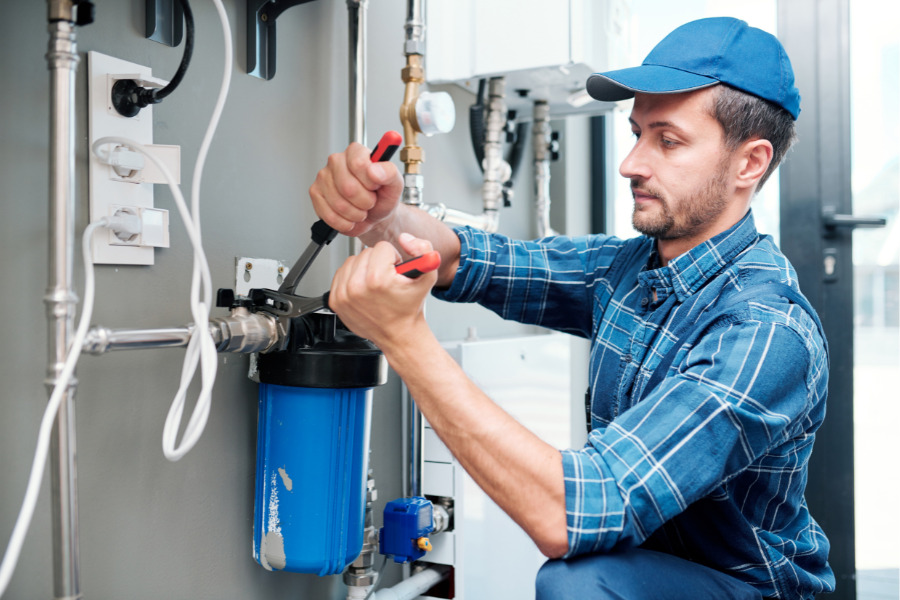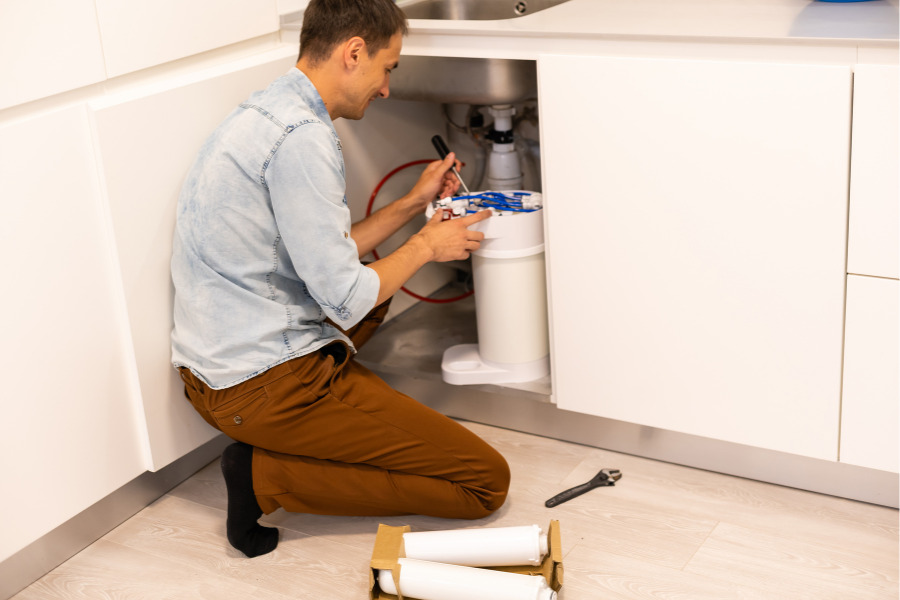Why is my Reverse Osmosis System Constantly Draining?
Understanding Reverse Osmosis Systems
How Reverse Osmosis Works:
At its core, reverse osmosis is a process that utilizes a semi-permeable membrane to separate water molecules from dissolved salts and other contaminants present in the water. The concept of osmosis forms the basis of this technology. Osmosis is a natural process where water moves through a membrane from an area of lower concentration to an area of higher concentration to equalize the concentration on both sides of the membrane.
In reverse osmosis, the process is reversed by applying external pressure to the concentrated side of the membrane, forcing water molecules to move against the natural osmotic flow. This pressure allows pure water to pass through the membrane, leaving behind the impurities, salts, and contaminants on the other side. The purified water is collected for use, while the concentrated water with the rejected contaminants is discharged as waste. If you’re looking for the best reverse osmosis system to invest in for your house, click here for more information.
Key Components of a Reverse Osmosis System:
a. Pre-filters: RO systems typically incorporate pre-filters to remove larger particles, sediment, and chlorine from the water before it reaches the semi-permeable membrane. These pre-filters protect the membrane from damage and improve its efficiency.
b. Semi-permeable Membrane: The heart of the reverse osmosis system is the semi-permeable membrane. This specialized membrane features microscopic pores that allow water molecules to pass through while blocking the larger molecules of contaminants.
c. Pressure Pump: To achieve the required pressure for the reverse osmosis process, a pressure pump is employed. This pump ensures that the water reaches the membrane with sufficient force to overcome the natural osmotic pressure.
d. Storage Tank: The purified water is collected in a storage tank, ready for use on-demand. The tank allows the RO system to produce water continuously, even when water consumption is low.
e. Automatic Shut-off Valve (ASO): The ASO is a crucial safety feature that stops water production once the storage tank is full. This prevents excessive drainage and water wastage.
f. Post-filters: After leaving the storage tank, the purified water passes through post-filters, which further refine the taste and remove any residual odors, ensuring the water meets the desired quality standards.
Normal Drainage Process in Reverse Osmosis
In a reverse osmosis (RO) system, the drainage process is an integral part of its efficient functioning. As water passes through the RO system’s semi-permeable membrane, contaminants and impurities are removed, resulting in two distinct streams: purified water and wastewater. Understanding the normal drainage process helps us appreciate the importance of wastewater discharge and how it contributes to the overall efficiency of the reverse osmosis system.
Separation of Pure and Waste Water:
As untreated water enters the reverse osmosis system, it first encounters pre-filters designed to remove larger particles, sediment, and chlorine. The pre-filtered water then enters the semi-permeable membrane under pressure. The membrane allows water molecules to pass through its microscopic pores while blocking the larger molecules of contaminants, such as dissolved salts, minerals, and other impurities.
Production of Purified Water:
The water that successfully passes through the semi-permeable membrane and emerges on the other side is purified water. This purified water, now free of most contaminants and impurities, is collected and directed into a storage tank. The storage tank allows the RO system to produce and store a certain amount of purified water for on-demand use.
Generation of Waste Water:
Simultaneously, the contaminants and impurities that do not pass through the membrane accumulate on the other side, forming a concentrated stream of water. This concentrated water, carrying the rejected contaminants, is known as wastewater or brine. It is automatically directed to a drain or discharged through a separate outlet.
Importance of Waste Water Discharge:
Wastewater discharge serves several critical purposes in the operation of a reverse osmosis system:
a. Preventing Concentrate Buildup: The accumulation of rejected contaminants on the membrane surface could lead to fouling and decreased performance. By continually flushing away the wastewater, the reverse osmosis system prevents the buildup of concentrated contaminants, maintaining the efficiency of the membrane.
b. Maintaining Osmotic Pressure: The continuous flow of wastewater ensures that the pressure difference across the membrane remains constant. This pressure is necessary to overcome the natural osmotic flow and allow the purification process to take place effectively.
c. Maximizing Water Efficiency: While wastewater is, by definition, not used for drinking or other purposes, it plays a crucial role in maximizing the overall water efficiency of the RO system. Without wastewater discharge, the system would require much more untreated water to produce the same amount of purified water.
Potential Causes of Excessive Drainage in a Reverse Osmosis System
While reverse osmosis (RO) systems are highly efficient in purifying water, excessive drainage can sometimes be a cause for concern. Experiencing higher than normal waste water production may indicate underlying issues affecting the system’s performance. Identifying and addressing these potential causes can help optimize the RO system’s efficiency and reduce water wastage. Below are some common factors that may lead to excessive drainage in a reverse osmosis system:
Clogged or Faulty Pre-filters and Membranes:
Over time, pre-filters can become clogged with sediment, debris, and other particles present in the feed water. Clogs in the pre-filters restrict water flow to the membrane, leading to decreased efficiency and increased wastewater production.
A worn-out or damaged membrane may also allow more impurities to pass through, requiring additional wastewater to flush away rejected contaminants.
Inadequate Pressure or Low Water Temperature:
Reverse osmosis relies on sufficient water pressure to force water molecules through the semi-permeable membrane. Low water pressure can result in slower filtration and higher wastewater production.
Additionally, lower water temperatures can reduce the effectiveness of the RO process, leading to higher rejection rates and increased wastewater.
Malfunctioning Automatic Shut-off Valve (ASO):
An improperly functioning ASO may fail to shut off the water production process when the storage tank is full. This can lead to continuous drainage as the system continues to produce purified water even when not required.
Incorrect Ratio of Pure to Waste Water:
RO systems are designed to maintain a specific ratio of purified water to wastewater, often referred to as the recovery rate. If this ratio is not properly balanced, either due to system misconfiguration or component issues, excessive drainage can occur.
System Leakage and Seal Issues:
Any leaks in the system can disrupt the proper flow of water, leading to unnecessary wastewater production. Leaks may occur in the connections, tubing, or around fittings.
Faulty seals or O-rings can also contribute to leaks, affecting the overall performance of the RO system.
Aging or Poorly Maintained Components:
Over time, various components of an RO system may deteriorate, leading to reduced efficiency. Regular maintenance is crucial to ensure optimal performance and minimize wastewater production.
Failure to replace worn-out or expired parts, such as filters and membranes, can negatively impact the system’s ability to remove contaminants effectively.
High TDS Levels in Feed Water:
Total Dissolved Solids (TDS) in the feed water can affect the performance of the RO system. If the feed water has exceptionally high TDS levels, the system may require more water to dilute the concentrated waste stream, resulting in increased drainage.
Incorrect System Sizing:
In some cases, the RO system may be improperly sized for the specific water demand. An undersized system may struggle to meet the demand, leading to higher wastewater production as it attempts to keep up.
Identifying the specific cause of excessive drainage in a reverse osmosis system requires a systematic approach and, in some cases, professional assistance. Regular maintenance, proper system configuration, and addressing issues promptly can help ensure optimal performance, water efficiency, and longevity of the RO system.
RO System Maintenance and Troubleshooting
Regular maintenance and prompt troubleshooting are crucial for ensuring the efficient and reliable operation of a reverse osmosis (RO) system. A well-maintained RO system not only delivers high-quality purified water but also minimizes wastewater production and extends the lifespan of the system’s components. This article provides valuable insights into the importance of RO system maintenance and offers practical troubleshooting tips to address common issues that may arise.
Importance of RO System Maintenance:
Proper maintenance is essential to keep an RO system in optimal condition. Here are some key reasons why regular maintenance is critical:
a. Sustained Water Quality: Regular maintenance ensures that the RO system continues to produce clean and safe drinking water. Dirty or clogged filters, worn-out membranes, or other issues can compromise water quality and may even lead to health concerns.
b. Efficient Water Production: A well-maintained RO system operates more efficiently, maximizing the production of purified water while minimizing wastewater discharge. This translates to cost savings and a reduced environmental footprint.
c. Prolonged Component Lifespan: Timely replacement of filters, membranes, and other consumables prevents premature wear and tear, leading to longer-lasting components and a more durable RO system.
d. Reduced Downtime and Repairs: Regular maintenance helps identify and address minor issues before they escalate into major problems. This prevents unforeseen breakdowns and expensive repairs.
RO System Maintenance Checklist:
Follow this maintenance checklist to ensure the optimal performance of your RO system:
a. Replace Pre-filters: Check and replace sediment and carbon pre-filters regularly. The frequency of replacement depends on water quality and usage, but it’s typically recommended every 3-6 months.
b. Monitor Membrane Condition: Inspect the RO membrane for signs of fouling or scaling. Replace the membrane as needed, usually every 2-3 years, to maintain efficient filtration.
c. Clean or Replace Post-filters: Post-filters, such as activated carbon filters, should be cleaned or replaced per the manufacturer’s guidelines to improve taste and remove residual odors.
d. Check Water Pressure: Ensure the system receives adequate water pressure. Low pressure can lead to reduced water production and increased wastewater.
e. Inspect for Leaks: Regularly check all connections, tubing, and fittings for leaks. Address any leaks promptly to avoid water wastage and damage to the system.
f. Monitor TDS Levels: Measure the Total Dissolved Solids (TDS) of the feed water and purified water regularly to gauge the system’s effectiveness. Rising TDS levels may indicate a failing membrane.
g. Clean the Storage Tank: Periodically clean and sanitize the storage tank to prevent bacterial growth and maintain water freshness.
h. Maintain the Pressure Pump: If your RO system includes a pressure pump, inspect it regularly to ensure proper functioning. A malfunctioning pump can hinder water production.
i. Follow Manufacturer’s Guidelines: Adhere to the manufacturer’s maintenance instructions specific to your RO system model.
Troubleshooting Common RO System Issues:
Despite regular maintenance, RO systems may encounter issues that require troubleshooting. Here are some common issues and possible solutions:
a. Low Water Production:
• Check for clogged filters or faulty membranes. Replace them if necessary.
• Verify water pressure and ensure it meets the minimum requirements.
b. Excessive Waste Water:
• Inspect for leaks and fix them promptly.
• Check the Automatic Shut-off Valve (ASO) to ensure it is functioning correctly and shutting off water production when the tank is full.
c. High TDS Levels in Purified Water:
• Test the feed water to determine if it has exceptionally high TDS levels. If so, consider pre-treatment options such as water softening or additional filtration.
d. Poor Taste or Odor:
• Clean or replace post-filters to improve water taste and remove odors.
e. Slow Water Flow:
• Verify water pressure and check for clogs in the pre-filters and membrane.
f. Noisy Operation:
• Inspect the pressure pump and other moving parts for any issues. Lubricate or replace them as needed.
When to Seek Professional Assistance:
While many RO system maintenance tasks can be performed by the user, some issues may require professional expertise. Consider seeking professional assistance in the following situations:
a. Persistent Problems: If issues persist despite troubleshooting attempts, a professional technician can conduct a thorough inspection to identify the root cause.
b. Membrane Replacement: Replacing the RO membrane can be a more complex task that requires specific technical knowledge.
c. System Upgrades: For system upgrades or adjustments to improve water efficiency, professional guidance is valuable.
d. Regular Servicing: Periodic professional servicing can ensure comprehensive maintenance and identify potential problems before they become significant.
In conclusion, maintaining a reverse osmosis system is essential for consistent water quality and system performance. By following a regular maintenance routine and promptly addressing any issues that arise, users can ensure that their RO system operates efficiently and provides high-quality purified water. Troubleshooting common problems empowers users to handle minor issues themselves, while professional assistance ensures a well-maintained and reliable RO system for years to come.


